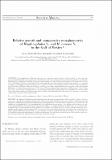Por favor, use este identificador para citar o enlazar a este item:
http://hdl.handle.net/10261/28309COMPARTIR / EXPORTAR:
 SHARE
BASE SHARE
BASE
|
|
| Visualizar otros formatos: MARC | Dublin Core | RDF | ORE | MODS | METS | DIDL | DATACITE | |

| Título: | Relative growth and comparative morphometrics of Mugil cephalus L. and M. curema V. in the Gulf of Mexico |
Autor: | Ibáñez Aguirre, Ana Laura; Lleonart, Jordi CSIC | Palabras clave: | Relative growth Morphometrics Mugil cephalus Mugil curema Gulf of Mexico Crecimiento relativo Morfometría Golfo de México |
Fecha de publicación: | jun-1996 | Editor: | Consejo Superior de Investigaciones Científicas (España) | Citación: | Scientia Marina 60(2-3): 361-368 (1996) | Resumen: | [EN] The morphometric differences between two congeneric species, Mugil cephalus and M. curema, and their sexes are studied through ten measurements. The allometries of each measurement are estimated in relation to total length. Morphometric variations are analysed using three transformations: (i) logarithmic transformation, (ii) division of each variable by total length, and (iii) normalization of the individuals of each group; and three multivariate methods: (a) reciprocal averaging, (b) principal component analysis and (c) canonical analysis of populations. Results indicate that the morphology of both species is different, male and female M. cephalus were clearly discriminated into two groups, while no important differences were found between the sexes of M. curema. The separation of the groups, due to differences in “shape” rather than “size” was observed through analysis of reciprocal averaging and canonical analysis of populations by normalization of the individuals in each group. The morphometric variables that differentiated the four groups were thickness at maximum width, length to anal fin and cephalic length. [ES] Se estudian las diferencias morfométricas entre dos especies congenéricas. Mugil cephalus Mugil curema, y sus sexos empleando diez medidas somaticas. Las alometrías de cada medida se estiman en relación a la longitud total. Se analizan las variaciones morformétricas mediante tres transformaciones: (i) transformación logarítmica, (ii) división de cada variable por la longitud total y (iii) normalización de los individuos de cada grupo; y tres análisis multivariantes: (a) análisis de correspondencias, (b) análisis de componentes principales y (e) análisis canónico de poblaciones. Los resultados indican diferencias en la morfología de ambas especies |
Descripción: | 8 páginas, 5 figuras, 5 tablas | Versión del editor: | http://www.icm.csic.es/scimar/index.php/secId/6/IdArt/2794/ | URI: | http://hdl.handle.net/10261/28309 | ISSN: | 0214-8358 | E-ISSN: | 1886-8134 |
| Aparece en las colecciones: | (ICM) Artículos |
Ficheros en este ítem:
| Fichero | Descripción | Tamaño | Formato | |
|---|---|---|---|---|
| Ibañez_et_al_1996.pdf | 6,32 MB | Adobe PDF |  Visualizar/Abrir |
CORE Recommender
Page view(s)
490
checked on 19-abr-2024
Download(s)
310
checked on 19-abr-2024
Google ScholarTM
Check
NOTA: Los ítems de Digital.CSIC están protegidos por copyright, con todos los derechos reservados, a menos que se indique lo contrario.
